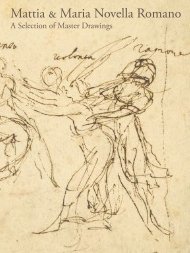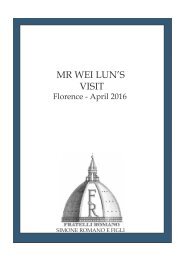A Selection of master drawings 2014
- No tags were found...
Create successful ePaper yourself
Turn your PDF publications into a flip-book with our unique Google optimized e-Paper software.
2. Giovanni Baglione<br />
Rome c. 1566 - 1643<br />
An Allegory <strong>of</strong> the Reconciliation <strong>of</strong> Charity and Justice<br />
Charcoal and traces <strong>of</strong> lead white on cerulean paper<br />
353 x 253 mm. (13 ⅞ x 10 in.)<br />
Giovanni Baglione was not only well known for his<br />
writings on art history 1 but he was also a prolific painter.<br />
From the young age <strong>of</strong> fifteen he worked with a group <strong>of</strong><br />
artists, including Cesare Nebbia and Giovanni Guerra,<br />
who were favoured by the patronage <strong>of</strong> Pope Sixtus V, who<br />
commissioned them to paint the frescoes <strong>of</strong> the salone <strong>of</strong> the<br />
Vatican Library and <strong>of</strong> Palazzo Lateranense. In the 1590s,<br />
after spending two years in Naples, Baglione returned to<br />
Rome as a renowned and acclaimed artist. The frescoes for<br />
San Giovanni in Laterano and for Santa Maria dell’Orto<br />
date to this period (1598-1599). Thereafter Baglione<br />
gradually abandoned his late-mannerist style as he became<br />
intrigued and fascinated by Caravaggio’s painting, becoming<br />
one <strong>of</strong> his closest followers. Significant examples from this<br />
period are the paintings <strong>of</strong> St Francis in Ecstasy (Davidson<br />
Collection, Santa Barbara Museum <strong>of</strong> Art) and Sacred Love<br />
and Pr<strong>of</strong>ane Love (Galleria Nazionale d’Arte Antica, Palazzo<br />
Barberini) in addition to Saints Peter and Paul (1601) and<br />
St Andrew (1603) both in the Church <strong>of</strong> Santa Cecilia<br />
in Trastevere. This phase ended shortly after due to the<br />
tormented relationship with Caravaggio, culminating in<br />
1603 when Baglione took a libel action against him. From<br />
this moment onwards Baglione abandoned the naturalistic<br />
style to pursue his own, which resulted in many important<br />
commissions such as the frescoes in the Cappella Paolina in<br />
Santa Maria Maggiore (1611-1612) and in the Resurrection<br />
<strong>of</strong> Tabitha for St Peter’s.<br />
One <strong>of</strong> his most illustrious patrons was Ferdinando<br />
Gonzaga Duke <strong>of</strong> Mantua, whom Baglione met in Rome<br />
in 1610 when the Duke was nominated Cardinal. The<br />
relationship established between them was such that<br />
Baglione was invited by the Duke to spend time at his<br />
court in Mantua between 1621 and 1622. In addition to<br />
the famous series named Apollo and the Nine Muses (Musée<br />
des Beaux-Arts, Arras), sent as a gift to Maria de’Medici in<br />
France, Baglione was commissioned by the Duke to paint<br />
the imposing Allegory <strong>of</strong> the Reconciliation <strong>of</strong> Charity and<br />
Justice, now in the Royal Collection at Kensington Palace<br />
in London.<br />
The present sheet is a preparatory study for this important<br />
work, signed and dated 1622 2 , depicting a complex<br />
allegorical subject matter. Baglione took inspiration from<br />
Renaissance thinkers who believed that Justice must be<br />
tempered by Divine Mercy. The artist here substitutes<br />
the latter with Charity, Divine Love. The two Virtues,<br />
Justice and Charity are shown chained together in the<br />
foreground reconciled by Divine Wisdom who holds<br />
the golden chain from above. A secular theme revisited<br />
from a Catholic perspective, possibly to fulfil the wishes<br />
<strong>of</strong> Cardinal Ferdinando Gonzaga. This is evident in the<br />
present drawing where the figure above the clouds holds<br />
a cross to symbolise Faith while in the painting it clearly<br />
represents Wisdom. This is further supported by the<br />
Latin inscription, taken from the first verse <strong>of</strong> the Book<br />
<strong>of</strong> Wisdom ‘Love righteousness, ye that be judges <strong>of</strong> the<br />
earth’ placed on the shield held by Justice. At the top only<br />
the dove remains to symbolise divine aspiration. Another<br />
small variation can be found in the figure <strong>of</strong> Justice who<br />
in our sheet holds the sword, which in the painting is<br />
placed on the ground. With his background as a highly<br />
educated man <strong>of</strong> letters, Baglione created an accomplished<br />
and sophisticated work <strong>of</strong> art which was undoubtedly<br />
appreciated by his patron, well versed in both religious and<br />
classical texts. In the Gonzaga inventory <strong>of</strong> 1626-1627,<br />
the painting was recorded as in the Galleria della Mostra<br />
in the Palazzo Ducale.





